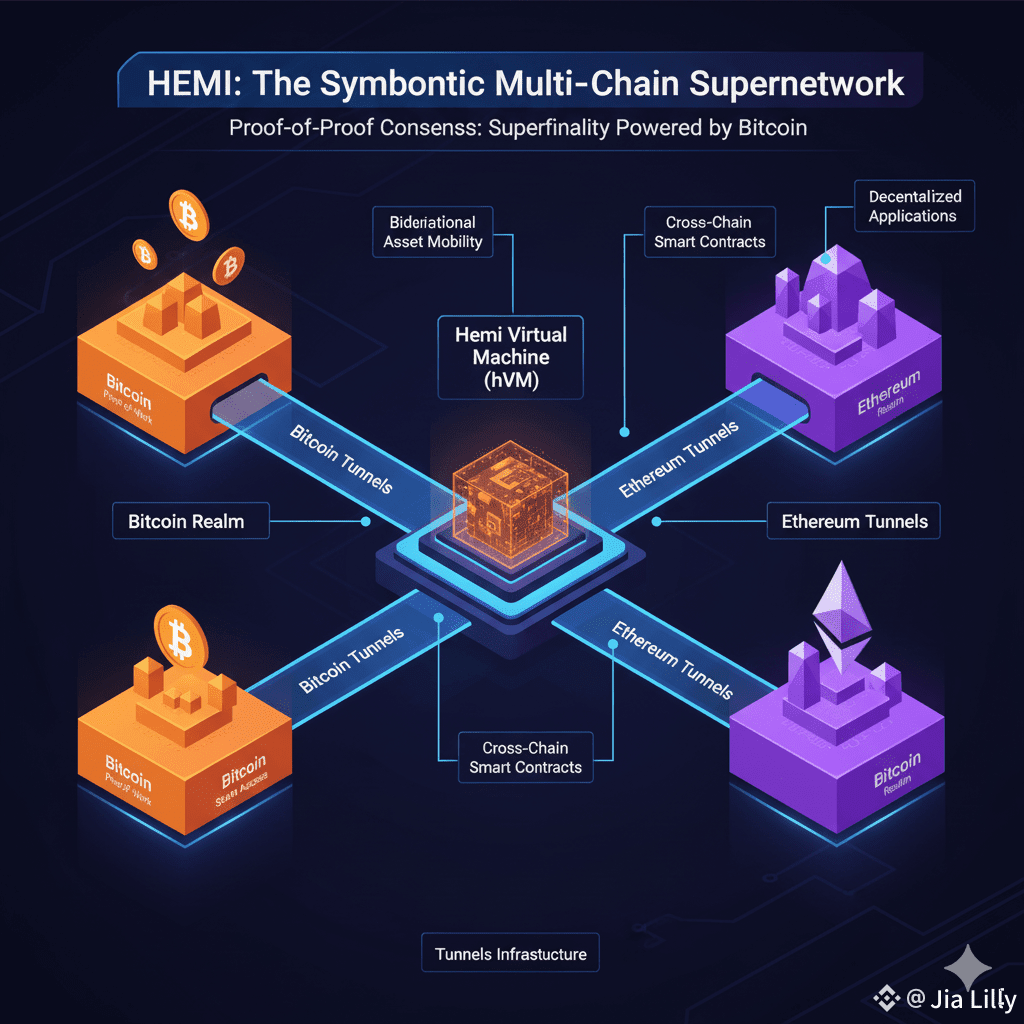 of blockchain interoperability, transcending conventional Layer-2 scalability solutions to instantiate a genuinely symbiotic multi-chain infrastructure. The protocol's foundational premise acknowledges that Bitcoin and Ethereum evolved as complementary yet isolated technological paradigms—Bitcoin epitomizing cryptographic immutability and censorship resistance through proof-of-work consensus, while Ethereum pioneered Turing-complete programmability through smart contract execution environments. Historical fragmentation between these ecosystems generated systemic inefficiencies, with each chain developing insular communities, liquidity pools, and application layers that rarely achieved meaningful interoperation. Hemi's intervention addresses this bifurcation through a modular supernetwork architecture that synthesizes Bitcoin's settlement finality with Ethereum's computational expressiveness, effectuating a unified execution layer where cross-chain logic and value transfer occur natively rather than through intermediated bridge protocols vulnerable to custodial risks and cryptographic exploits.
of blockchain interoperability, transcending conventional Layer-2 scalability solutions to instantiate a genuinely symbiotic multi-chain infrastructure. The protocol's foundational premise acknowledges that Bitcoin and Ethereum evolved as complementary yet isolated technological paradigms—Bitcoin epitomizing cryptographic immutability and censorship resistance through proof-of-work consensus, while Ethereum pioneered Turing-complete programmability through smart contract execution environments. Historical fragmentation between these ecosystems generated systemic inefficiencies, with each chain developing insular communities, liquidity pools, and application layers that rarely achieved meaningful interoperation. Hemi's intervention addresses this bifurcation through a modular supernetwork architecture that synthesizes Bitcoin's settlement finality with Ethereum's computational expressiveness, effectuating a unified execution layer where cross-chain logic and value transfer occur natively rather than through intermediated bridge protocols vulnerable to custodial risks and cryptographic exploits.
The Hemi Virtual Machine constitutes the protocol's most consequential technical innovation, embedding a complete Bitcoin full node within an EVM-compatible execution environment. This architectural integration transcends superficial cross-chain messaging to enable smart contracts with direct, trustless access to Bitcoin's UTXO set, block headers, and Merkle proof structures. Developers can construct Solidity-based applications that programmatically verify Bitcoin transaction authenticity without oracle dependencies, eliminating the trust assumptions inherent in traditional wrapped asset schemes. This native Bitcoin state accessibility facilitates unprecedented composability patterns—decentralized applications can condition execution logic on Bitcoin blockchain events with cryptographic certainty, creating programmable contingencies that span both ecosystems simultaneously. The hVM thereby transforms Bitcoin's historically static value layer into programmable infrastructure while preserving its fundamental security properties, effectuating a paradigm where Bitcoin's trillion-dollar settlement assurance becomes accessible to sophisticated DeFi primitives previously confined to Ethereum's domain.
Hemi's Proof-of-Proof consensus mechanism represents a heterodox approach to Layer-2 security, anchoring state commitments directly to Bitcoin's blockchain through periodic cryptographic attestations. This anchoring strategy enables what Hemi designates as "superfinality"—state immutability guaranteed by Bitcoin's cumulative proof-of-work rather than economic staking models or fraud-proof challenge periods. By batching transaction state into Merkle roots embedded within Bitcoin transactions, Hemi inherits Bitcoin's settlement guarantees, rendering state reversals computationally infeasible without rewriting Bitcoin's ledger itself. However, this security inheritance introduces temporal trade-offs: Bitcoin's ten-minute block intervals necessitate careful calibration of anchoring frequency to balance finality latency against transaction cost economics. Frequent anchoring accelerates definitive settlement but amplifies operational expenses through Bitcoin network fees, while extended anchoring intervals reduce costs but expand vulnerability windows before state commitments achieve irreversibility. This optimization challenge exemplifies blockchain's perpetual trilemma—Hemi's architecture consciously prioritizes security and decentralization while managing scalability constraints through periodic settlement batching rather than continuous real-time finality.
The Tunnels infrastructure operationalizes bidirectional asset mobility between Bitcoin, Ethereum, and Hemi through cryptographically verifiable locking and minting mechanisms. Unlike centralized bridge architectures vulnerable to custodial capture or multisignature collusion, Tunnels leverage hVM's embedded verification capabilities to authenticate cross-chain transfers through native blockchain state queries. When users deposit Bitcoin into Hemi, the hVM's Bitcoin node independently validates transaction inclusion and finality before authorizing corresponding token issuance on Hemi's execution layer, eliminating reliance on external validator sets or oracle networks. This verification architecture significantly attenuates bridge exploitation vectors that historically plagued cross-chain infrastructure, though implementation complexity around confirmation thresholds, liquidity provisioning, and state synchronization demands rigorous auditing protocols to prevent subtle vulnerabilities in cryptographic proof construction or state commitment logic.
Hemi's viability ultimately depends on ecosystem adoption dynamics and competitive positioning against established Layer-2 solutions. The protocol's technical sophistication addresses genuine architectural limitations in existing cross-chain infrastructure, yet network effects favor incumbents with mature developer tooling, liquidity depth, and application ecosystems. Success requires demonstrating compelling advantages—whether through superior security guarantees, reduced transaction costs, or unique interoperability capabilities—sufficient to attract critical mass participation. The HEMI token's role in transaction settlement, validator incentivization, and governance coordination introduces additional complexity around tokenomics design, distribution equity, and long-term sustainability mechanisms. Hemi's modular architecture positions it as genuinely novel blockchain infrastructure, but transforming technical innovation into adopted protocol infrastructure demands navigating the intricate socioeconomic coordination challenges inherent in decentralized network bootstrapping and sustained ecosystem cultivation across multiple blockchain communities.



